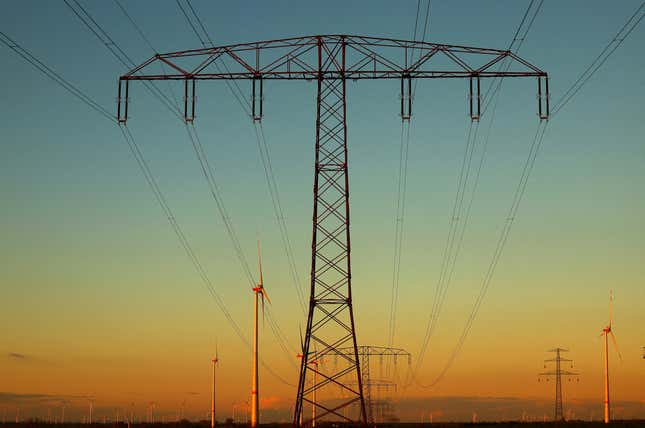
Renewables are having a bumper run, according to JP Morgan’s annual assessment (pdf) of the energy market. More money is being invested into clean tech than fossil fuels—and this was true even before the US Inflation Reduction Act flushed the climate industry with $370 billion. Power generation is speeding up: The US generated as much renewable energy in the last five years as in the previous 20.
One thing trending in the wrong direction, however, is transmission: the capacity of the power grid to bring renewable energy from where it’s generated to where it’s used. For decades, transmission growth in the US was already slow at 1.5%. According to the JP Morgan report, growth has slowed further to 1% over the last five years.
To match the US’s decarbonization ambitions, transmission growth will have to ramp up to 5.7% annually by 2048. The national transmission infrastructure—made up of the power lines that carry electricity and the miles-long rows of pylons they are hoisted onto—need to expand by 60% by 2030 and may need to triple by 2050, according to the US energy department. But numerous obstacles threaten to stand in the way.
Why is the US struggling to expand its power grid?
A Feb. 2023 report by the Lawrence Berkeley National Laboratory found that the volume of new electric capacity waiting to be connected to the grid is “growing dramatically.” At the end of 2022, power projects capable of collectively generating 2,040 gigawatts (GW) were in the queue—meaning that they’d filed requests to be hooked up to the grid and were in various stages of planning or construction. This was more than the installed 1,250 GW capacity of the entire US power plant fleet. Over 95% of this energy waiting in the wings comes from renewables like solar, wind, and battery storage.
Most of these projects have yet to be completed. (The Berkeley report noted that only 10-16% of the intended projects had been completed, but it did not specify how many projects were halted for lack of access to the grid.) For finished projects, the US’s limited grid capacity is creating friction. The average wait time to be hooked up to the grid is increasing. For projects that came online in 2022, it took five years from request to operation. In 2015, that wait was three years, and fewer than two years in 2008.
There are many knotty reasons for the lag in laying new power lines. It can be difficult to secure permits and access to land, often obstructed by people who object to power lines being draped across their skies. Local and state governments may pass legislation by, for example, blocking eminent domain, in order to protect local interests at the expense of the national power grid. Federal efforts to create inter-state transmission corridors, in which swathes of land are designated to host transmission infrastructure, have likewise been stymied by state opposition.
It can also be difficult to integrate thousands of small solar, wind, and battery storage projects, distributed widely across the US, onto the grid. On average, wind farms—which could be built out in the gusty, sparsely populated plains of North Dakota, for example—and hydropower projects are located further from towns and cities than natural gas or nuclear power stations. The greater the distance, the longer the power lines that need to be laid.
The US is far behind other countries in laying high-voltage power lines
The US currently has 2,462 kms (1,529 miles) of high voltage direct current (HVDC) lines—the kind that optimize transmission of renewable energy from remote locations. This is 19 times less than China, and comparable to Denmark, a country 230 times smaller than the US.
In January 2022, the US energy department announced an initiative to improve the power grid with $20 billion in funding. But JP Morgan doesn’t expect that to dramatically improve the situation for renewables in the near future. According to the report, the US is not projected to add more HVDC lines before 2026. By contrast, India is projected to increase its transmission capacity eightfold in the same time period, from 19,087 km to 165,635 km.